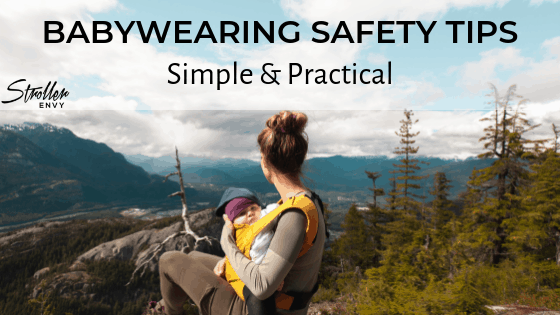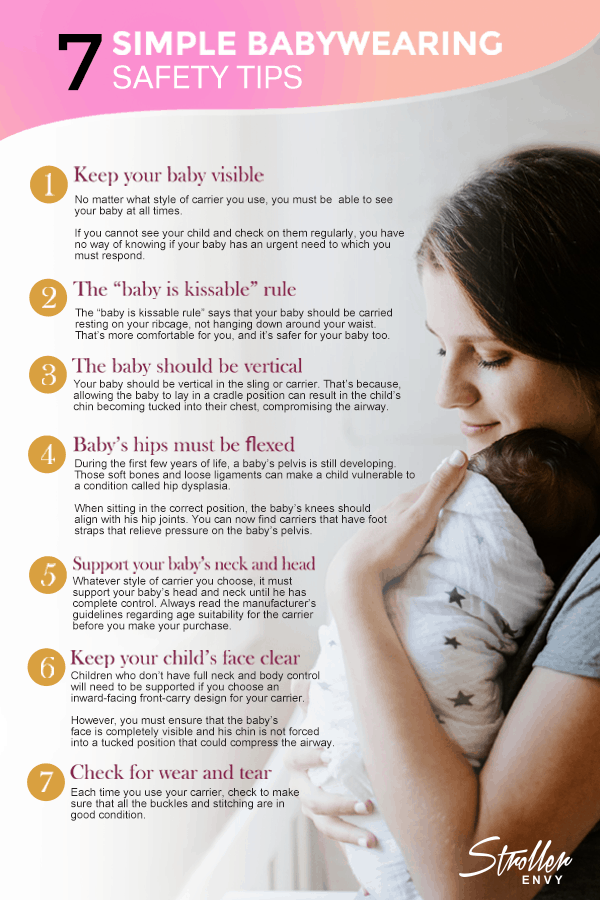Babywearing is a practice that has been around for as long as there have been babies!
However, carrying your little one in a baby sling has recently become the in-thing among many modern parents.
So, what is babywearing, and how can you make sure that your child stays safe and happy?
Table of Contents
What is babywearing?
Babywearing is an ancient practice dating back hundreds of years.
Parents use a piece of cloth, a baby sling, or a specially designed carrier to bear the child, leaving mom or dad’s hands available for other tasks.
Although you may have seen historical pictures of a baby being carried in a sling on his mother’s back, that’s not the safest method of babywearing.
So, here are seven simple tips on safe babywearing practice for the modern mom or dad.
Keep your baby visible
No matter what style of carrier you use, you must be able to see your baby at all times.
If you cannot see your child and check on them regularly, you have no way of knowing if your baby has an urgent need to which you must respond.
If you do opt for a baby carrier that places the child on your back, you must ensure that the baby’s face is uncovered. You can then look in a mirror and check on the baby or ask someone else to look for you.
The “baby is kissable” rule
The “baby is kissable rule” says that your baby should be carried resting on your ribcage, not hanging down around your waist. That’s more comfortable for you, and it’s safer for your baby too.
The sling or carrier must be adjustable to fit the caregiver. That could mean that you’ll need to buy more than one sling to fit each person who is going to be nominated as babywearer.
The baby should be vertical
Your baby should be vertical in the sling or carrier. That’s because, allowing the baby to lay in a cradle position can result in the child’s chin becoming tucked into their chest, compromising the airway.
With the baby upright, he can breathe freely. Also, your little one will have a much better view of the big wide world around them when carried in this position.
Baby’s hips must be flexed
During the first few years of life, a baby’s pelvis is still developing. Those soft bones and loose ligaments can make a child vulnerable to a condition called hip dysplasia.
Hip dysplasia occurs when the ball and socket of the hip joint become misaligned. To prevent damage to the baby’s pelvis when he’s being carried, choose a carrier that allows your infant to sit in the carrier with the backs of your baby’s thighs supported.
When sitting in the correct position, the baby’s knees should align with his hip joints. You can now find carriers that have foot straps that relieve pressure on the baby’s pelvis.
Support your baby’s neck and head
Whatever style of carrier you choose, it must support your baby’s head and neck until he has complete control.
Always read the manufacturer’s guidelines regarding age suitability for the carrier before you make your purchase.
Keep your child’s face clear
Children who don’t have full neck and body control will need to be supported if you choose an inward-facing front-carry design for your carrier.
However, you must ensure that the baby’s face is completely visible and his chin is not forced into a tucked position that could compress the airway.
Note that premature babies, infants under four months of age, and children who have a pre-existing breathing condition or cold are at significant risk of suffocation.
Wear and tear safety checks
Each time you use your carrier, check to make sure that all the buckles and stitching are in good condition.
Safety first, always.
Always think about safety when you’re out and about with your baby in his carrier.
Never drink hot liquids while you’re babywearing.
If you drop something, always bend at the knee, rather than your hip, supporting your baby with one hand.
Final thoughts
Babywearing is a great way of building a closer bond with your child.
Choose a carrier that provides your baby with support for his head and neck and places his hips in the correct position to avoid injury.
Make sure that your child’s face is left clear of any obstruction and that his chin is not tucked in, potentially causing interference with his breathing.
Sources:


